48th Fighter Wing in Action
RAF Lakenheath, Suffolk
July 2006
|
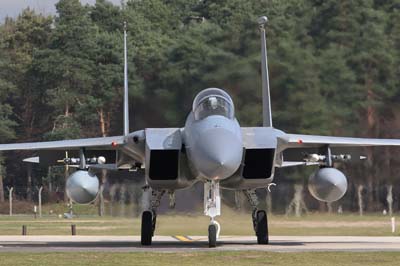 Philip Stevens reports on some very active days for crews flying the F-15C Eagle and F-15E Strike Eagle at RAF Lakenheath in Suffolk, United Kingdom. Lakenheath is the home of United States Air Forces in Europe's (USAFE) 48th Fighter Wing (FW) and is arguably the most potent aerial fighting force in Europe, employing the McDonnell Douglas (now Boeing) F-15 Eagle.
Philip Stevens reports on some very active days for crews flying the F-15C Eagle and F-15E Strike Eagle at RAF Lakenheath in Suffolk, United Kingdom. Lakenheath is the home of United States Air Forces in Europe's (USAFE) 48th Fighter Wing (FW) and is arguably the most potent aerial fighting force in Europe, employing the McDonnell Douglas (now Boeing) F-15 Eagle.
The 48th FW and known as 'Liberty Wing' is fulfilling USAFE's NATO responsibilities to provide combat-ready air wings, from bases that are spread from United Kingdom to Turkey. Since the end of the Cold War these forces have been cut by 67%. In the UK in the 1970s and 80s there were multiple wings of F-4s, A-10s and F-111s operating from five major air bases. This has now been reduced to one wing of F-15s supported by the 100th ARW with it's fleet of KC-135 aerial refuelling tankers based nearby at RAF Mildenhall. We wanted to find out more about Lakenheath's operations and it's aircraft.
At the time of our visit Lakenheath was involved in an Operational Readiness Exercise which was to run for four days. The exercise included mock deployments and emergency response training. Airmen were to receive pre-deployment briefings as in real world situations and operate with minimal manning and also train to respond to emergency situations. "This exercise is important for the training and readiness of our Airmen", said Col. Jay Silveria, 48th FW vice commander. "Readiness is key to our defence as well as the defence of our allies. |
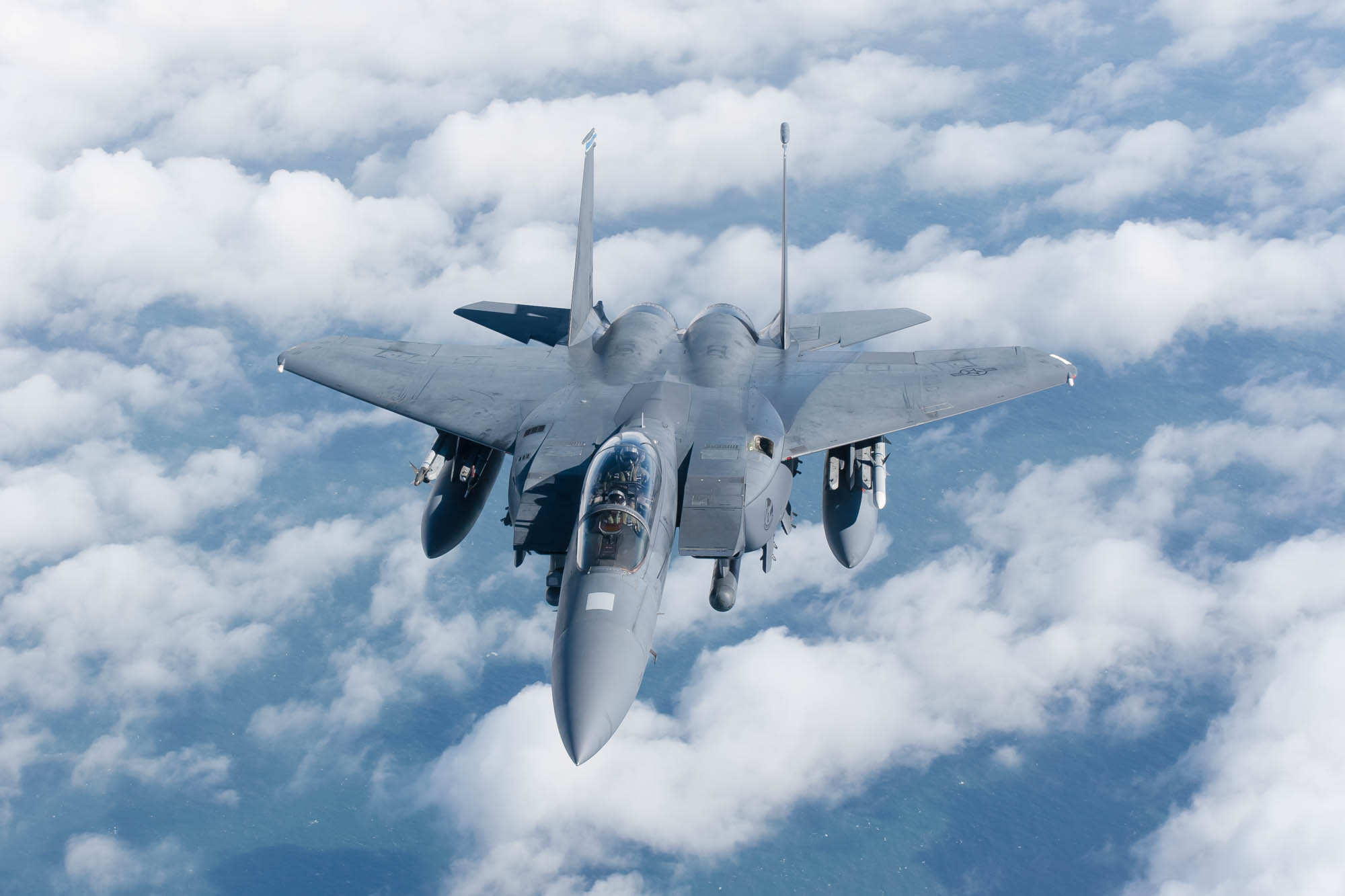 |
| F-15E Strike Eagle (98-0131 'LN') of 492nd FS with its blue and white fin tip markings. |
The 48th FW comprises of three squadrons. The 493rd Fighter Squadron (FS) has 40 pilots and is equipped with 24 single seat F-15C Eagles and are exclusively used in the air superiority role. The 492nd FS and 494th FS fly the two-seat F-15E Strike Eagle which has the dual capability of ground attack, both conventional and nuclear and air superiority. These two squadrons are also assigned 24 aircraft each for the 38 pilots and 38 Weapon Systems Officers (WSO). To make sure all three squadrons are at full strength at all times; each will have an extra three or four aircraft available.
|
The F-15 Eagle/Strike Eagle
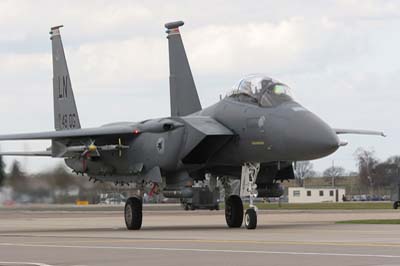
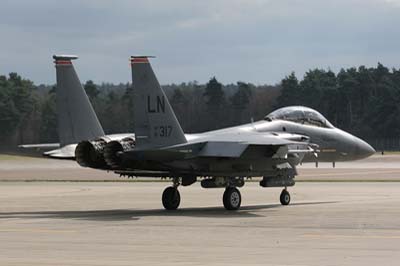 The F-15A first flew back in 1972, followed by the F-15B in 1973, F-15C and F-15D in 1979 and F-15E in 1986. 1,090 F-15s were delivered to the USAF from 1974 and over 400 are still in service with the USAF or Air National Guard (ANG) and remain the backbone of the USAF. The F-15 is an all-weather, highly manoeuvrable tactical fighting aircraft. Designed to out perform all enemy aircraft to give it total air supremacy, which has been proven in a number of conflicts. During the Balkan war, F-15s brought down four Serbian MiG-29s and were responsible for 33 of the 35 kills of fixed wing aircraft during the first Gulf War.
The F-15A first flew back in 1972, followed by the F-15B in 1973, F-15C and F-15D in 1979 and F-15E in 1986. 1,090 F-15s were delivered to the USAF from 1974 and over 400 are still in service with the USAF or Air National Guard (ANG) and remain the backbone of the USAF. The F-15 is an all-weather, highly manoeuvrable tactical fighting aircraft. Designed to out perform all enemy aircraft to give it total air supremacy, which has been proven in a number of conflicts. During the Balkan war, F-15s brought down four Serbian MiG-29s and were responsible for 33 of the 35 kills of fixed wing aircraft during the first Gulf War.
The F-15C/D/Es can achieve Mach 2.5 in level flight, which was measured at 1,665 mph (2,655 km/h) at 36,000 feet (10,975m). It can climb at a maximum rate of 50,000 feet per minute and has a service ceiling of 65,000 feet (19,810m). With conformal fuel tanks its range is 3,100 nm (5,745 km) with an endurance of 5 hours 15 minutes.
Lakenheath's F-15Cs of the 493rd FS routinely operate at medium altitudes typically 20,000 to 30,000 feet (6,096 to 9,144 meters) Above Mean Sea Level (AMSL) and flying missions of up to two hours in duration with aerial refuelling. |
The Eagle has been ruling the skies for over 30 years
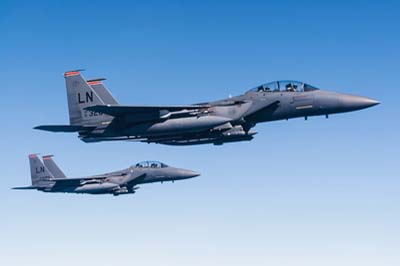 Air superiority is the name of the game for the F-15, in-conjunction with its upgraded APG-63 radar, it uses some very potent weaponry. The AIM-9M is the standard short-range air-to-air missile used by all three of Lakenheath's F-15 squadrons. The original AIM-9 was developed in the 1950s, but has improved considerably since those days to enhance its effectiveness. It is a supersonic, heat-seeking missile and resistant to electronic counter-measures. Using infrared guidance systems it can be used day and night and once launched the pilot is able to take any necessary evasive action and leave the area. The latest variant, the AIM-9X, has slightly improved performance. However it's main advancement is its compatibility with the Joint Helmet-Mounted Cueing System (JHMCS), which enable pilots to more easily acquire the target and decrease workload. Using information displayed in the pilot's visor, the pilot does not have to be flying towards the target, but just has to look in its direction before 'lock-on' is achieved. A $86 million contract was awarded to Boeing in 2004 for 2,000 JHMCS systems, with deliveries starting in 2005.
Air superiority is the name of the game for the F-15, in-conjunction with its upgraded APG-63 radar, it uses some very potent weaponry. The AIM-9M is the standard short-range air-to-air missile used by all three of Lakenheath's F-15 squadrons. The original AIM-9 was developed in the 1950s, but has improved considerably since those days to enhance its effectiveness. It is a supersonic, heat-seeking missile and resistant to electronic counter-measures. Using infrared guidance systems it can be used day and night and once launched the pilot is able to take any necessary evasive action and leave the area. The latest variant, the AIM-9X, has slightly improved performance. However it's main advancement is its compatibility with the Joint Helmet-Mounted Cueing System (JHMCS), which enable pilots to more easily acquire the target and decrease workload. Using information displayed in the pilot's visor, the pilot does not have to be flying towards the target, but just has to look in its direction before 'lock-on' is achieved. A $86 million contract was awarded to Boeing in 2004 for 2,000 JHMCS systems, with deliveries starting in 2005.
For targets of around 20 miles (32Km) pilots would select the supersonic AIM-120 Advanced Medium-Range Air-to-Air Missile (AMRAAM) produced by Hughes and Raytheon is a Beyond Visual Range (BVR) air-to-air missile. It has been around since 1991 and has now replaced the slower and larger AIM-7M Sparrow which has not been used at Lakenheath for several years now.
The Eagle is fitted with the General Electric M61A1 20mm gun but is only used as a last resort in aerial combat. Recently the gun has been used for attacking slow moving ground targets specifically in Iraq. At Lakenheath I was told that ground strafing had not been added to the training schedule.
The F-15E Strike Eagle Packs a Punch
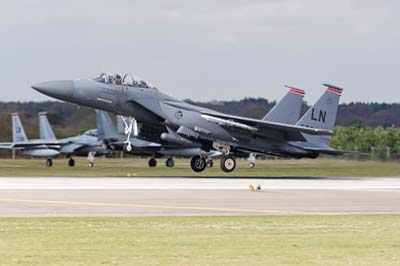
The F-15E Strike Eagle in its ground attack role, packs an extra punch with its precision guided weapons. Joint Direct Attack Munition (JDAM) were introduced in 1997 and are satellite (GPS) guided weapons. GPS co-ordinates can be programmed before or during flight for both the intended target and the release point. They are very accurate against fixed targets and are unaffected by poor weather. Speaking to the crews at Lakenheath we found that JDAM weapons are very popular, as they can be released at high altitudes above typical ground threats, such as Surface to Air Missiles (SAM) and Anti-Aircraft Artillery (AAA) and can be released up to 15 miles from the target.
The F-15E has an extensive range of munition available to it, including the 500lb (227Kg) Mark.82, 1000lb (454kg) Mark.83 and 2000lb (907kg) Mark.84 basic 'dumb' bombs. Laser Guided Bombs (LGBs) include; 5000lb (2268kg) Guided Bomb Unit-28 (GBU-28) 'Bunker buster' with a 4000lb (1814kg) penetrating warhead, it was used with great effect to penetrate hardened Iraqi command centres. Another LGB is the GBU-15 glide bomb. Introduced in 1983 and enhanced in 2001 with GPS targeting, the weapon can be automatically guided, using the weapon guidance system, or manually guided using remote control after launch, to the target for pin point accuracy. In poor visibility and for countering sophisticated enemy air defences, the GBU-24 Paveway III is used. This is a Low-level Laser Guided Bomb (LLLGB) with a 2000lb (907kg) Mark.84 warhead.
A weapon that is about to be introduced is the 250lb (113kg) GBU-39 Small Diameter Bomb which is GPS guided and is designed for fixed or stationery targets where collateral damage is to be avoided. It is ideal in an urban environment.
Eagle Pilots Know What's Going On
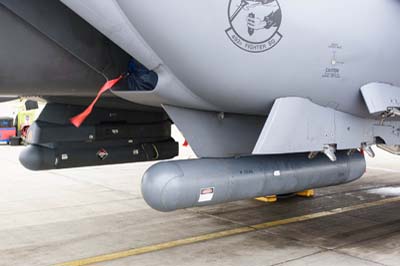 |
LANTIRN, an all-weather navigational and targeting system, is only really used in wintertime when it gets dark earlier. Technically LANTIRN allows them to fly in all weathers, but training rules do not allow it. |
The F-15E Strike Eagle is equipped with the Low Altitude Navigational and Targeting Infrared for Night (LANTIRN) enabling the F-15E to fly at low altitudes at night and in adverse weather to deliver weapons to ground targets. LANTIRN consists of an AN/AAQ-13 navigational pod and a separate AN/AAQ-14 targeting pod. Using terrain following radar the navigational pod enables the pilot to follow the contours of the ground at a pre-selected altitude, well below 500 feet (152m). The pilot sees an infrared image of the ground in front of the aircraft on a head-up display. LANTIRN was developed for the F-15E and F-16 Fighting Falcon, it was modified for the F-14 Tomcat. The targeting pod contains a high-resolution forward-looking infrared sensor which provides the Weapons System Officer (WSO) in the back seat with an infrared image of the target. A laser designator-range-finder provides precise delivery of laser guided munitions.
The relatively new Joint Tactical Information Data System (JTIDS) or 'Link 16' is one of the most valuable tools for our pilots, we were told. JTIDS is a data link that provides the pilot with a situational report of what other pilots and surveillance aircraft like the E-3D are seeing. F-15 pilots have reported drastic increases in situational awareness using JTIDS. In an exercise F-15s with JTIDS and E-3s took on F-15s without it and scored a four to one success ratio. The impressive success rate was put down to pilots with JTIDS being able to recognise friendly planes more easily, enabling them to focus on 'bandit' aircraft more
quickly. JTIDS is a multi-service and multi-national system. It is resistant to jamming and its data encryption makes it secure.
The latest targeting system the Lockheed Martin Sniper Advanced Targeting Pod (AN/AAQ-33), uses daylight video and infrared cameras. It generates GPS co-ordinates to be directly input into JDAMS and has a better resolution than LANTIRN. An F-15E WSO can now independently launch satellite-guided weapons on targets, previously ground support units were necessary to provide the co-ordinates. Col. Kent Laughbaum, 48th Operations Group commander, explained, "The sniper pod receives target co-ordinates directly from a satellite and communicates the information to the munition." The 494th FS were first unit to use it during 787 sorties and over 5,525 combat hours, when deployed to the Middle East between January and March this year. Lt. Col. Daniel Debree, 494th FS commander said "They performed marvellously, they are significant boost to our combat capability and to the level of support we were able to provide coalition ground troops." Also, "The Sniper Pod has been a long time coming," said Capt. Sean Lowe, who was able to test the pod. "It enhances the WSO's skills and the Strike Eagle's capabilities." The number of Sniper pod units available are limited and speaking to crew at Lakenheath not all WSO's have been able to try it out yet. The pods have been passed on to other Air Force units to test out, prior to any deployments.
The concept of using fighter aircraft equipped with targeting pods to monitor the battlespace is known as non-traditional intelligence, surveillance and reconnaissance (NTISR). "NTISR increases the cross-talk between the Army and the Air Force in joint operations," Major Fiorito said. Recently two F-15E Strike Eagles proved the value of this capability during a mortar attack on Balad Air Base, in Iraq. The aircraft were called to the scene by the base's Joint Defense Operation Center. Using their electro-optical and infrared sensor capability, they quickly located three insurgents fleeing in a vehicle from the scene. After following the suspects to a house, the aircraft relayed their location to ground forces. All three individuals were successfully detained.
Training to Attack and Fight
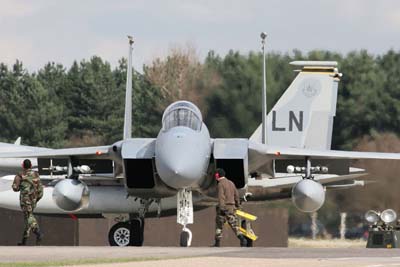
During our time at Lakenheath we were able to talk to crew about training, leading to an actual low-level training mission by a 492nd FS crew. Both 492nd FS and 494th FS fly the F-15E Strike Eagle and so have to train for their dual roles of air-to-air superiority and ground attack. We were told that about 50% of their training time is spent in each activity.
So how is training scheduled at Lakenheath? How much training we have to do each year is dictated by Department of Defense, this is split up amongst the crews so they all have same amount of practise in each area and equal numbers of missions each week. Speaking to crew we were told that air-to-air training such as two versus two's are carried out over the ocean, as they are worried about going supersonic over land. "We train in all sorts of different numbers (1v1, 2v2, 2v1, 2v multiple), including large forces for a broad variety, to give ourselves the best abilities for real conflicts."
What equipment or procedures are specifically used for training? A NATO procedure known as 'Fighting Edge' is available to most frontline fighters. This involves using a code in transponder to say that the fighter can be 'bounced' during the mission. "It is dependant on those who want to participate, some days no jets, other days there can be a few", we were told. All RAF jets use the system regularly.
We train mostly against the British, however during NATO cross service exercises, pilot Capt. Schmidt said they often fly with and against the air forces of the Netherlands, France and Belgium. Referring to a recent Tactical Leadership Program (TLP) held at Florennes Air Base in Belgium, she said, "It is an amazing experience to fly in large NATO groups with the Dutch, French and Belgians all flying together even the Greeks were there."
For training missions the F-15 will carry an Airborne Instrumentation Sub-system (AIS) Pod, this is essentially an electronic pod that transmits a package of information regarding the flight of the aircraft, such as altitude, speed, heading, G and angle of attack etc. All these data are received on the 'Air Combat Manoeuvring Instrumentation' (ACMI) equipped ranges on the ground for analysis. It is possible to follow air to air combat in real time very accurately within 15 feet (4.6m) and when the flight has ended the data can be used for a debriefing.
|
Captain Wilmic, Weapons System Officer (WSO) commented "With all points plotted I will get everything printed out, including the paperwork on the target attacks to make sure as 'wizzo' (WSO) we attack the right target to get good trade out of it. We will go over all the procedures necessary for what we are going to do that day, before going out to the aircraft for the pre-flight checks to make sure everything is working right."
The F-15E Strike Eagle with its blue and white tail band signifies it to be from 492nd FS for today's mission was fitted with;
On its main wing pylons, two 610 gallon drop tanks,
On its port intake pylon the AN/AAQ-14 LANTIRN targeting pod,
On its starboard intake pylon the AN/AAQ-13 navigational pod,
The centreline pylon a SUU-20 practice bomb dispenser carrying six BDU-33 practice bombs,
On the wing outer missile rail was AIM-9M Sidewinder blue banded training round,
On the wing inner missile rail was an AIS pod,
And finally on the port outer rail was an AIM-120 AMRAAM training round.
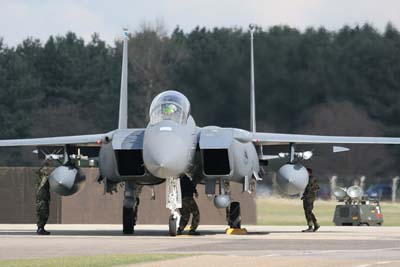
At the 'Last chance' point for final checks before crossing the runway the F-15E is held at the runway holding point. Cleared to depart the pair of F-15s climb out and head towards Air-to-Air Refuelling Area 8 (AARA 8) over the North Sea to meet up with 'Quid 22', a KC-135 tanker from 100 ARW based at nearby RAF Mildenhall. We were told; "training requirements dictate that a certain amount of time is required for air to air refuelling and also the tankers need the training. Both benefit in this symbiotic relationship."
All the weapons carried are blue banded inert training rounds, yellow bands are for live munition. For training they use a 'programmable armament control system', this allows the aircraft to believe that it has armed bombs onboard. It gives you all the cues for the normal programmable portions such as laser times and laser cues. Live weapons are used occasionally, but are not specifically scheduled for training. |
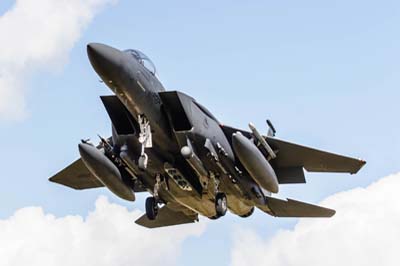
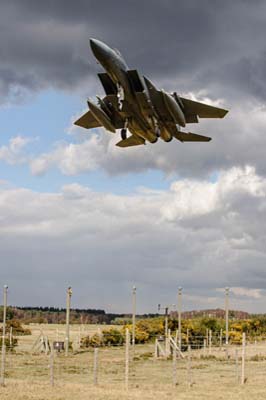 Back at Lakenheath they debrief maintenance, to let them know what happened to the jet and what condition it is in. Then on to the briefing room they all gather together for a group discussion. Here all rank comes off, the flight leader will debrief everyone on precisely what went wrong, regardless of rank and suggest what they can do next time to improve. It's a time when each person is very hard on the others in the formation, we were told.
Back at Lakenheath they debrief maintenance, to let them know what happened to the jet and what condition it is in. Then on to the briefing room they all gather together for a group discussion. Here all rank comes off, the flight leader will debrief everyone on precisely what went wrong, regardless of rank and suggest what they can do next time to improve. It's a time when each person is very hard on the others in the formation, we were told.
The Future
Earlier this year a Distributed Mission Operations (DMO) centre was opened at Lakenheath for F-15C mission training. Using high-fidelity 360 degree visual display flight simulators it provides pilots with realistic combat training so that they can "train like they would fight" we were told. This is the fifth Boeing supplied DMO it can be networked with other similar systems across the world. It is expected that all the Air Forces frontline aircraft and their weapons systems will be incorporated in the DMO program.With the recent closure of NAS Keflavik in Iceland, the 56th Rescue Squadron (56 RQS) moved its five HH-60G Pave Hawk helicopters to Lakenheath, the last two arrived in September.
The 48th FW has been used for the protection of Iceland since the permanently Iceland based F-15s of 57th FIS were inactivated in 1995.The Air Force is still looking to improve the F-15 yet further. Air Force Chief of Staff Gen. Moseley has started looking at upgrading the aircraft's radar. It has been decided that they need 196 F-15Cs to compliment the F-22A Raptor. The F-15E is also being considered for an avionics upgrade. Gen. Moseley said that one idea would be to have 'active electronically scanned array' radar. This solid-state type of radar has no moving parts and is already being used in the F-22A and in the newer F-16s. |
 |

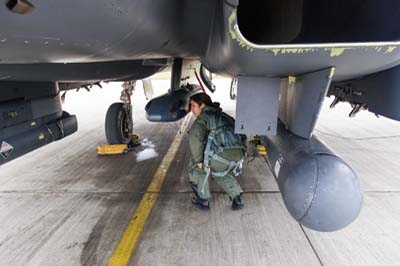
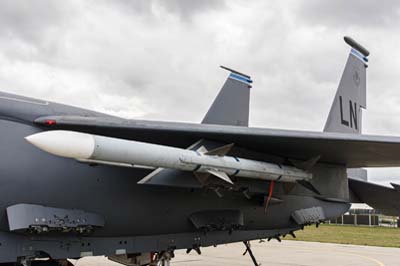
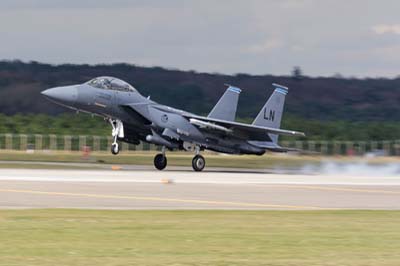
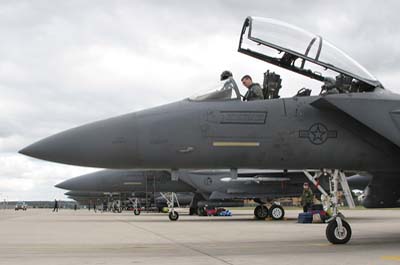


 Back at Lakenheath they debrief maintenance, to let them know what happened to the jet and what condition it is in. Then on to the briefing room they all gather together for a group discussion. Here all rank comes off, the flight leader will debrief everyone on precisely what went wrong, regardless of rank and suggest what they can do next time to improve. It's a time when each person is very hard on the others in the formation, we were told.
Back at Lakenheath they debrief maintenance, to let them know what happened to the jet and what condition it is in. Then on to the briefing room they all gather together for a group discussion. Here all rank comes off, the flight leader will debrief everyone on precisely what went wrong, regardless of rank and suggest what they can do next time to improve. It's a time when each person is very hard on the others in the formation, we were told.